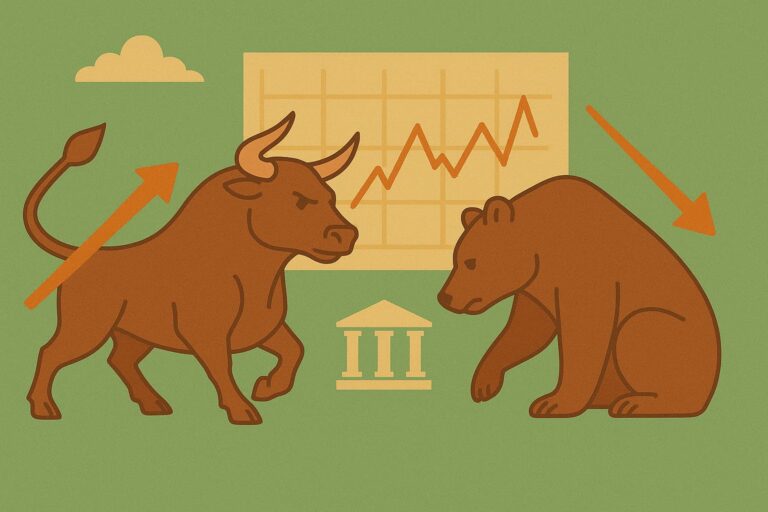If you’re like many investors, you might tune out when the news starts talking about bond yields—especially if you’re focused on stocks, crypto, or real estate.
But here’s the truth:
Bond yields affect everything from mortgage rates to stock prices to the health of the global economy.
Even if you don’t directly buy bonds, understanding how yields work—and what they signal—can help you make smarter investment and financial decisions.
What Are Bond Yields, Exactly?
A bond yield is the return an investor earns from holding a bond. Think of it like interest. For example:
- If you buy a $1,000 bond that pays $50 annually, your yield is 5%.
Yields move inversely to bond prices:
- If demand for a bond rises, its price goes up—and its yield goes down.
- If the price falls, the yield goes up.
Two Types of Yields to Know:
- Nominal Yield – The bond’s stated interest rate (fixed).
- Market Yield (or Yield to Maturity) – The real return considering current bond price, time to maturity, and interest payments.
Why Bond Yields Matter to the Broader Market
1. They Impact Interest Rates
Central banks (like the U.S. Federal Reserve) use bonds to influence monetary policy.
- When the Fed raises its target interest rate, bond yields usually rise.
- When the Fed lowers rates, bond yields tend to fall.
Why it matters:
Higher bond yields usually mean higher borrowing costs for businesses and consumers—affecting everything from credit card interest to home loans.
2. They Compete with Stocks
Bond yields often represent the “risk-free rate.” When yields are high:
- Investors may choose bonds over stocks, especially if the stock market looks volatile.
- High yields pull capital away from equities.
When yields fall:
- Investors might chase higher returns in stocks or crypto, pushing those prices up.
3. They Signal Investor Sentiment
Yields don’t just respond to central bank policies—they also reflect investor expectations.
- Rising yields = optimism about economic growth, inflation, or rate hikes.
- Falling yields = concerns about recession, deflation, or a flight to safety.
The 10-year Treasury yield, in particular, is a key barometer of market confidence.
Bond Yields and the Stock Market: A Love-Hate Relationship
You’ll often hear that rising yields are “bad” for the stock market. But it depends on the context.
| Scenario | Bond Yield Movement | Market Reaction |
|---|---|---|
| Strong economy, rising inflation | Yields rise | Stocks may pull back (rate fears) |
| Weak economy, falling inflation | Yields fall | Stocks may fall (recession fears) |
| Moderate growth, stable inflation | Yields steady | Stocks often rally |
Key point:
It’s not just the direction of the yield—but why it’s moving—that matters.
How Bond Yields Affect Your Life (Even Outside Investing)
Even if you never buy a bond, rising or falling yields impact your everyday finances:
1. Mortgage Rates
- The 10-year Treasury yield closely tracks 30-year mortgage rates.
- Rising yields = higher mortgage rates = more expensive home buying.
2. Student Loans & Credit Cards
- These are influenced by the broader interest rate environment.
- Higher yields = higher loan and credit card APRs.
3. Savings Accounts & CDs
- When yields rise, banks often offer better rates for savings and fixed deposits.
- Falling yields usually mean lower returns on savings.
4. Retirement Portfolios
- Many retirees rely on bond income.
- Higher yields can make bonds more attractive for income generation.
2025 Outlook: What’s Happening With Yields Now?
In recent years, bond yields have been especially volatile:
- In 2022, yields surged due to aggressive Fed rate hikes.
- In 2023–2024, they remained elevated as inflation stayed sticky.
- For 2025, many analysts expect modest rate cuts, possibly leading to gradually falling yields—but much depends on inflation and economic growth.
Key yield to watch: The U.S. 10-Year Treasury Yield
- Below 3% = dovish, low-growth expectations
- 3–4% = moderate, balanced environment
- Above 4% = concerns about inflation or aggressive Fed policy
How to Track Bond Yields (Easily)
You don’t need to be a bond trader to stay informed. Here’s how you can follow key bond metrics:
- Yahoo Finance / CNBC / Bloomberg – Real-time bond yield trackers
- TradingView – Charts for U.S. 10-year or 2-year yields
- Federal Reserve (FRED) – Historical data and economic releases
Pro Tip: Watch the yield curve
- A normal yield curve: Long-term yields > short-term yields
- An inverted yield curve: Short-term yields > long-term yields (often signals recession)
Final Thoughts: Don’t Ignore Bond Yields
You don’t have to be a bond expert to appreciate their impact.
- Bond yields influence your loans, your investments, and the global economy.
- They act like the heartbeat of the financial system—a subtle but powerful force that shapes markets behind the scenes.
So next time you hear “yields are rising” on the news, don’t change the channel. You just might learn something that helps your money go further.





